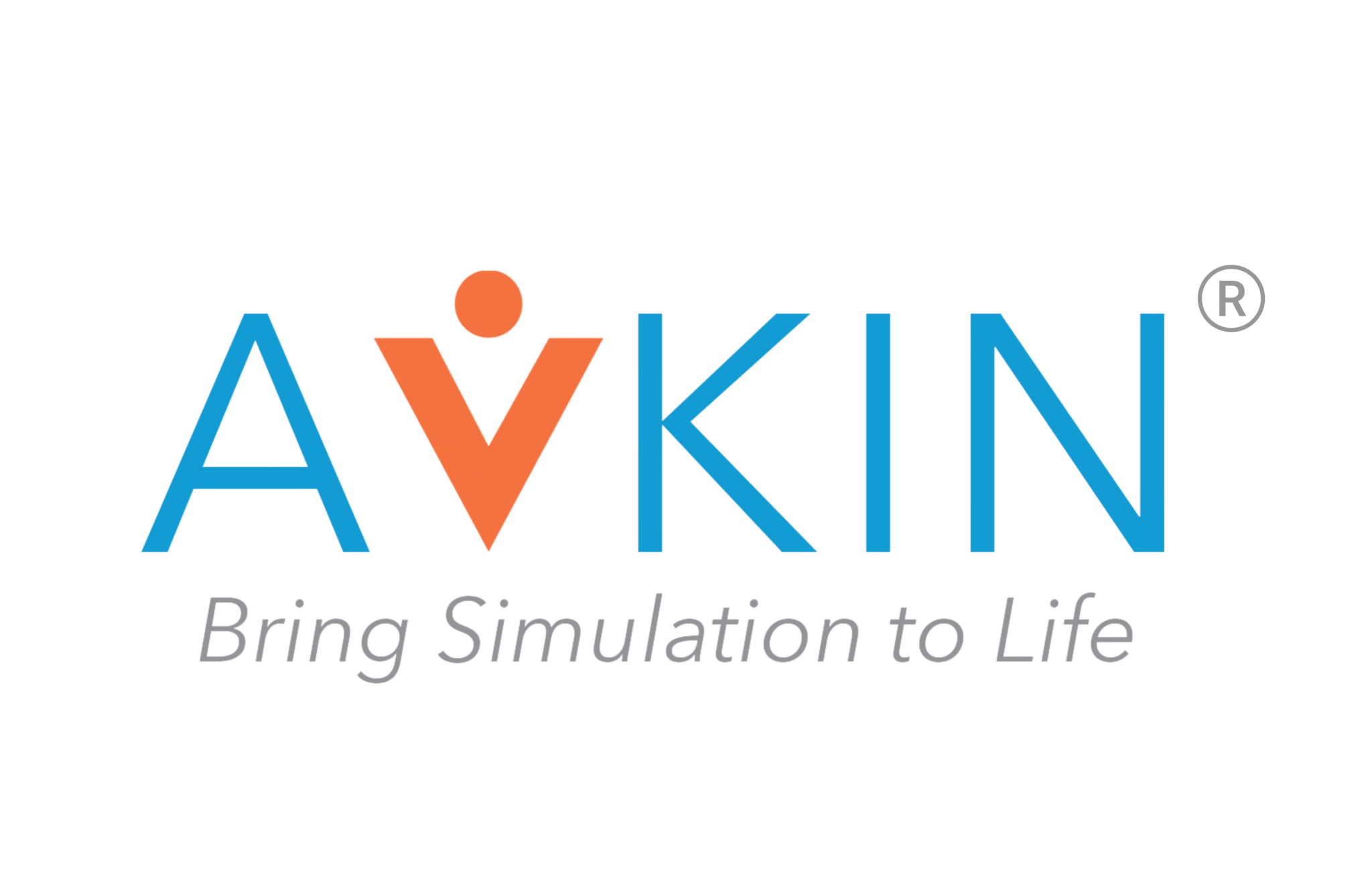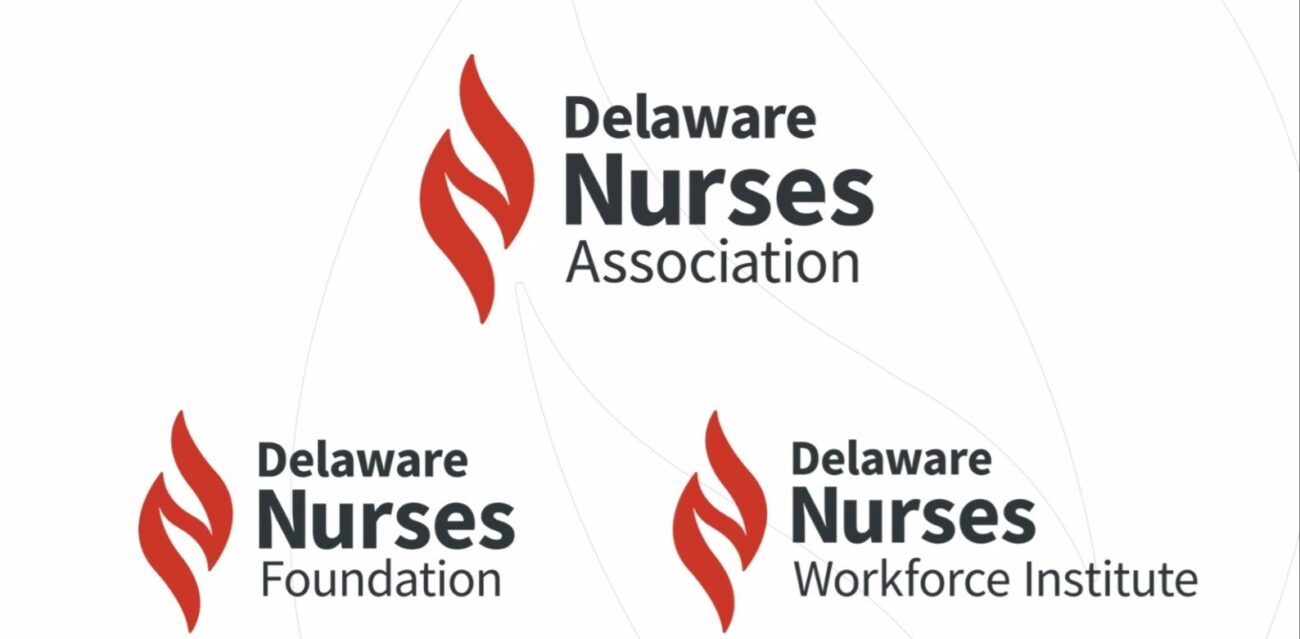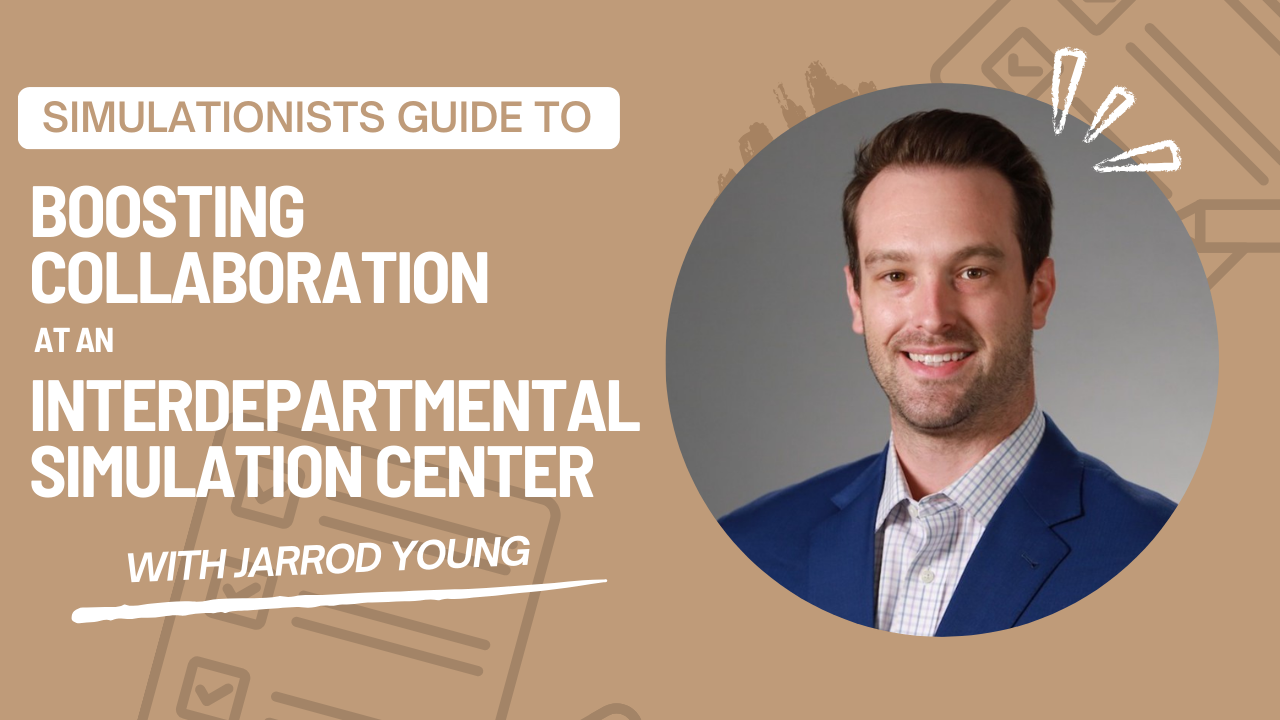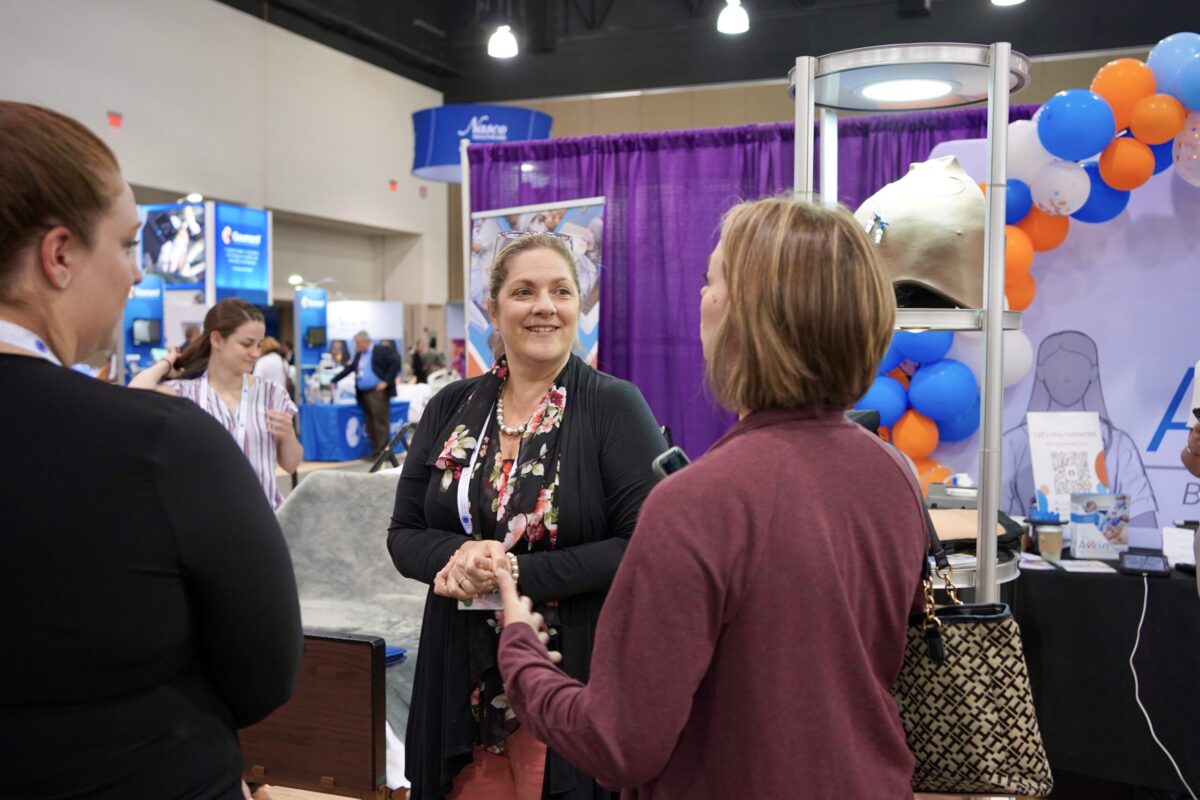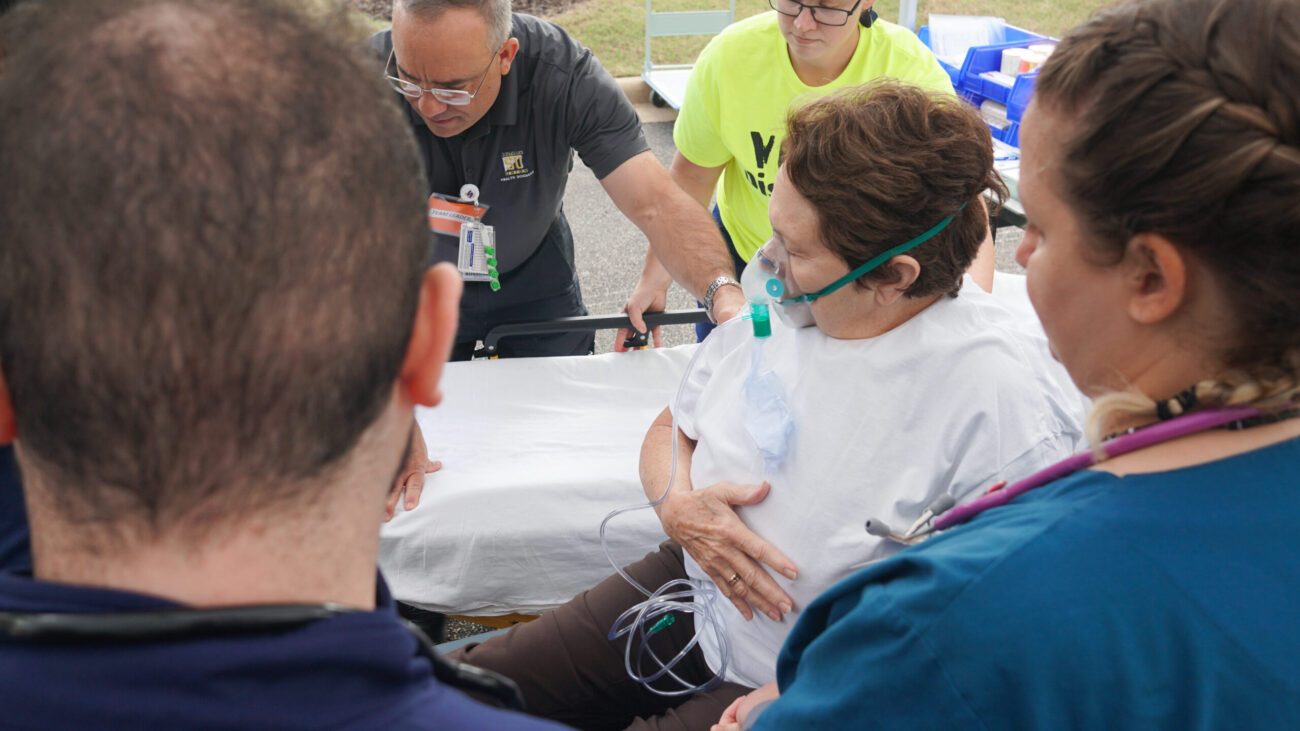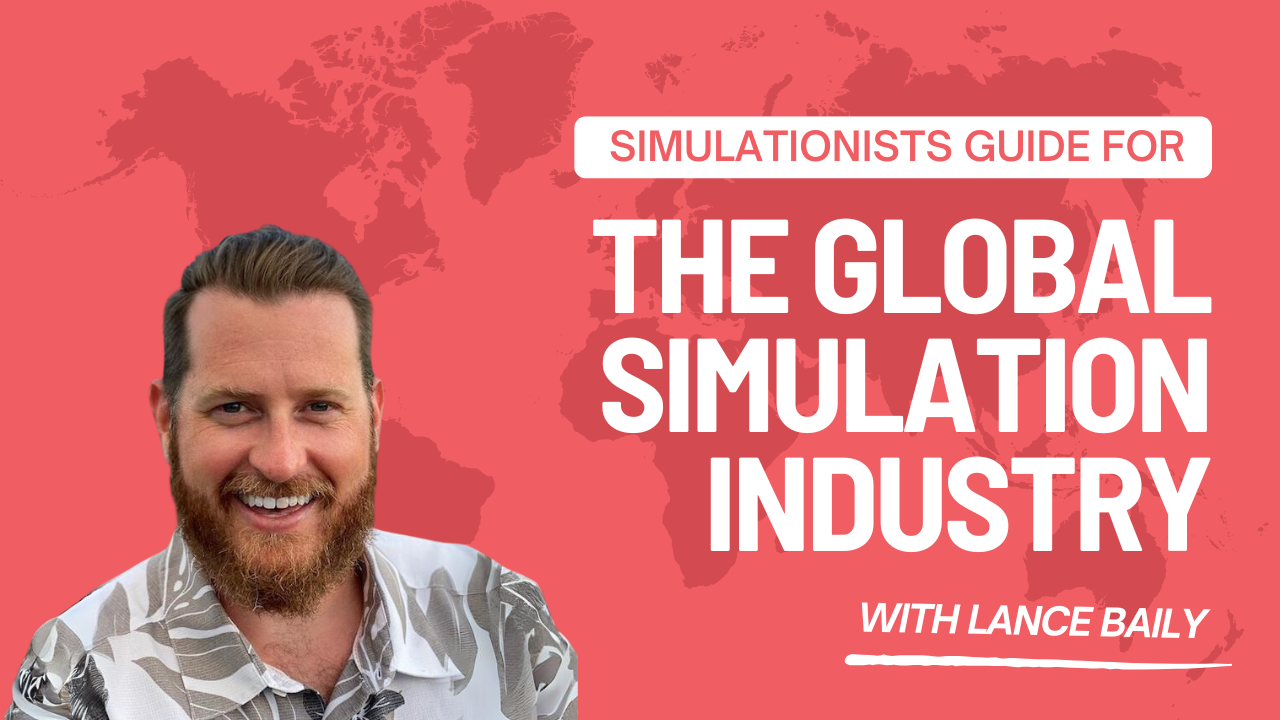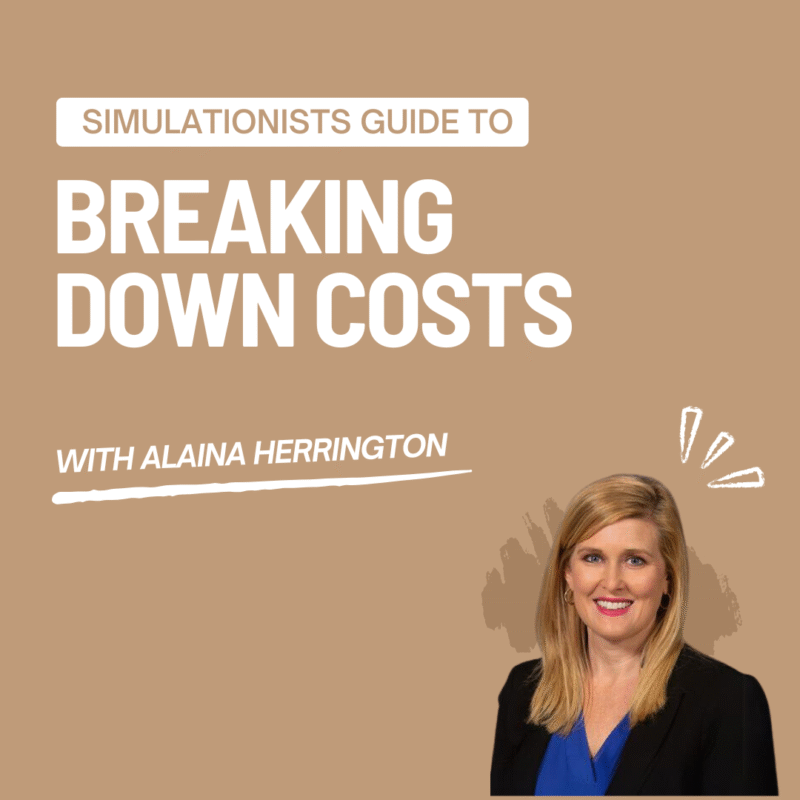Simulationist’s Guide to Designing a Simulation Lab
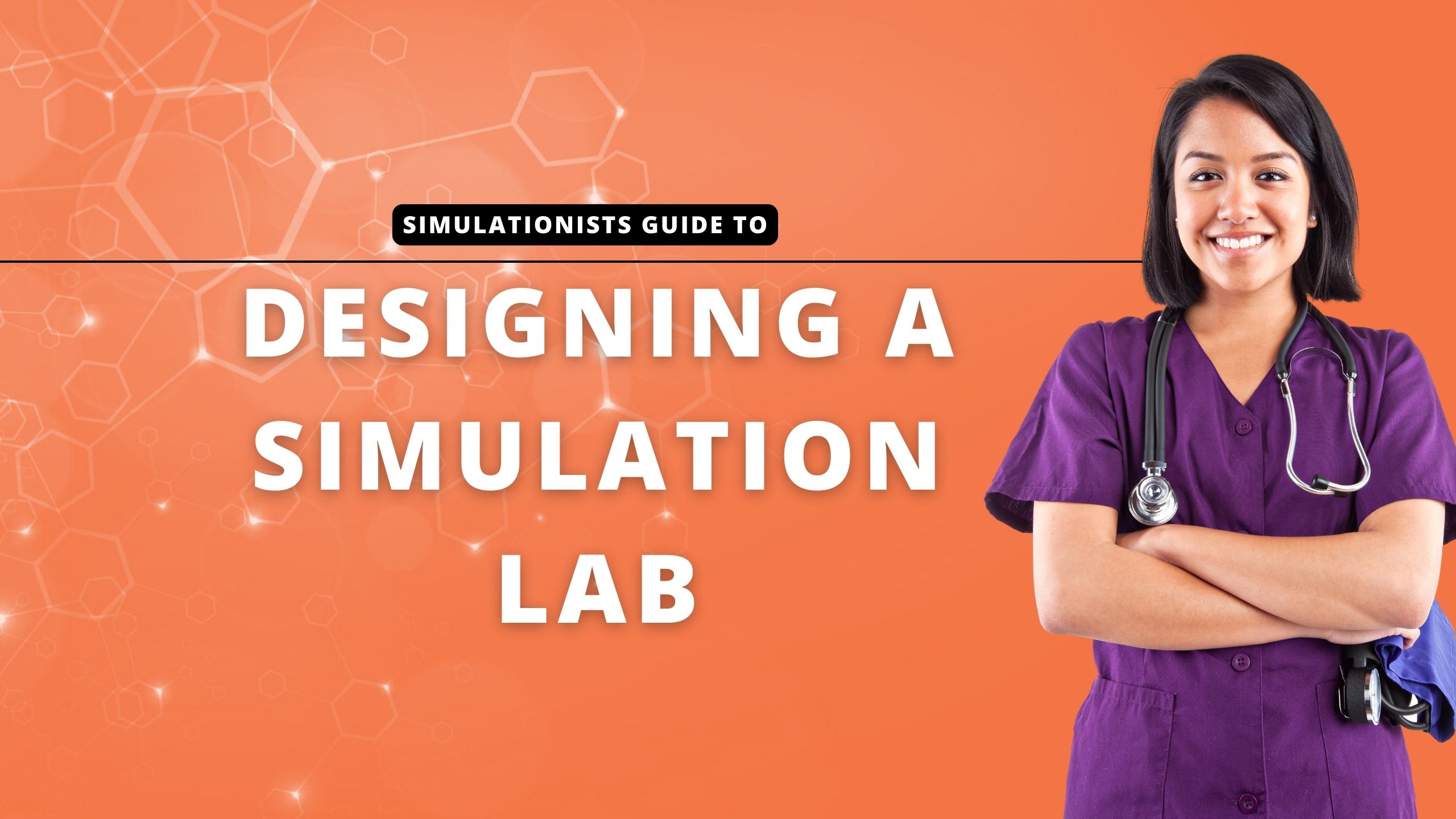
Simulation Nation Podcast – Simulationist’s Guide to Designing a Simulation Lab
Are you starting the process of designing and building a simulation center for your university? Your guide to designing a simulation lab is here and we want to share it with the simulation community!
The headaches, sleepless nights, stress and research that goes into designing a state of the art simulation lab can be a lot to handle. Amy Cowperthwait knows exactly what you are going through.
Whether you have a small budget or a $30 Million budget, you need to know what you can do with that money to create a functional learning environment while retaining realism.
Amy Cowperthwait CEO, RN, MSN, CNS, CHSE-A did just that, and goes through her guide on designing a simulation lab tha she developed as she was working at a University and she has the tips and tricks on how she was able to get it done with the help of Megan Cowperthwait.
What are some tricks that you would add to the Guide to Designing a Simualtion Lab? We would love to hear your thoughts! Comment on YouTube and you might hear your comment in an episode of Simulation Nation!
If you enjoyed our guide to designing a simulation lab, check out more episodes of Simulation Nation below, and subscribe to our podcast and Youtube so you never miss an episode!
Full Transcript:
Avkin Inc (00:18.002)
Hello everybody and welcome to Simulation Nation. This is, I think maybe my favorite topic in simulation to discuss. You think your favorite? I think. You have a lot of favorites. I have a lot of favorites, that’s true. I shouldn’t say that. This is definitely one that gets the juices. I get excited about this. If someone comes to me and talks to me and says, I need to know more about building a simulation, yeah, building my simulation center, designing my simulation center.
I think that could be a hobby for me. If I just was like sitting back and was like, yeah, let me just. That and travel planning. All the things. And writing simulations. Honestly, all the things. Creating characters. Yeah, you got it. There is, I recognize that 100%. There’s really things. But I am very excited about this because I think you and I have just been in such a unique position where we’ve gotten to go see so many sim centers. Yeah. And I think that normally.
That’s left to people who do the SSH accreditation. They’re able to go in and see a lot of centers as well. For sure. But just I think the average, we stick to our own area, maybe for regional conferences or simulation meetups. We’re able to go out and see other people’s sim centers. But I think it’s rare that you get to go across the country. And for me, globally, going to Australia and seeing sim centers, we’ve been to Dubai, Qatar, all of these different places, and seen
beautiful, amazing sim centers, I think that you get to take so many different pieces from all of these places. And now in my head, I think it’s kind of like almost like Barbie’s dream house. Like I can just kind of like put this place over here and this storage room here and this, you know, yeah. Well, one of the very early on in Avkin, you know, you have to create your three, three and five year plan and your business strategy. And I just remember being so overwhelmed by the idea of like, how do I do this? So my five year plan.
was a picture of a building. And that was the Sim Center that we were gonna design and build and do really, really good Sim at Fort Avkin and obviously like supporting other local colleges and universities and supporting our customers coming in. Now, obviously I was a little lofty. We haven’t gotten there. Yeah, that’s still on the wishlist. Still on the wishlist. But that was really my happy place. So the idea of being able to make my own decisions and not necessarily having leadership.
Avkin Inc (02:43.398)
slice things or change things. Yeah, final say on all of it. And just get to say, yes, we’re doing it. Having fun, having a really good time. And one wing of it was going to be simulation. The other wing was going to be research and development. So you can be developing the products and then testing them in the simulation center. And again, it’s not that desire has gone away. It’s just maybe a 20 year goal. It feels a little lofty right now. It’s kind of like, OK, now we’re going to take on designing. Maybe push that one out just a little bit. Just a little bit further. If I could. Yeah.
I would definitely be very happy about it for sure. Snap our fingers and it’s there. So I think the exciting thing with this episode is we don’t wanna just cover if you are going to be building that, right? Not everyone has the ability that they just have a $3 million budget sitting there. Me? No, no, no. Not three million. Three million, $10 million budget. 50 million. $50 million budget. Getting ready to build a brand new Simcenter. I think that what we’re gonna be covering is also some really interesting topics for people to be able to take and incorporate at their simulation center.
where again, they can just kind of modify or make changes and things like that. So again, we’re not gonna only be focusing on the state of the art building a brand new Simcenter. We’re also gonna just be focusing on some tips and tricks and things like that you can’t celebrate. Yeah, so there’s an HGTV show that’s no demo reno, right? So like, how do you do a reno without demoing walls or changing things around and.
I would have to say that I think I’m the master of that because I would always negotiate a new room with our dean or director every year or every other year. Just slowly creep into the next room and the next room and the next room. Next floor, next classroom takeover. Had COVID lasted much longer, I probably would have had most of that one side of McDowell Hall. Yeah, because no one was there. It wasn’t squatters’ rights at that point. Yeah, squatters’ rights, for sure. Yeah, just go in and start setting up some desks. I mean, what are they gonna do? Absolutely. Yeah.
So what would you say, someone who’s starting out building a Simcenter, because you’ve actually been through that process. I think I’ve observed the process of you going through a full build and things like that, but I wasn’t necessarily boots on the ground with that whole process. When we built the new building, and we could start from scratch with just our dreams rather than starting with the four walls that we had.
Avkin Inc (04:54.33)
I think the biggest challenge to that is the fact that you’re not the only one in the decision-making process. So when we were redoing a room or redoing an area, typically if it was an adult health space, I got most of the say, most of the time. Now that came with its own challenges because I would be asked questions that I didn’t know the answer to, and we’ll get to that in a few minutes, but the idea that you can dream about doing it the right way, because at that point the standards of best practice had been out.
had some exposure, not as much as we do today, but some exposure to other sim centers. I knew what I wanted to see. I knew what we needed, but it didn’t end up that I was the only one that got to make those decisions. And I think that was a really big surprise for me is that there are other people with their fingers in the pie. And at the end of the day, the architects are still gonna manipulate that floor plan,
Avkin Inc (05:54.314)
what you need. And you’ve got to be at every meeting and you’ve got to really make sure that they understand that the briefing room immediately adjacent to the simulation space is extremely important. Especially with sterilized patients. Well, yes. But again, that was part of the standards of best practice. And so that to me was…
really shocking in the end that I had stepped away for a short time to start the company. I’d had a leave of absence and when I got back, all of that was next and the entire floor plan was changed. Yeah. There was no discussion. Nobody came to me and asked me. It was just that a decision was made at a meeting with the architects and it got moved. Well, I think the other thing too though was that uniquely in your space and I’m sure this happens across the country.
But yours wasn’t just a sim center either. They were also trying to make it flex space for other classrooms and things like that too. And I had no idea that was the situation. And I think that’s hard too when there’s other motives there where they’re like, well, we can’t pin it in too much because they wanna use it for alternative things not knowing the full scope of what the goals are and things. I think that’s the other key piece there, especially when designing an interprofessional simulation space.
Yeah, and I think the idea is if they’re going to put so much money into it that they want to be able to maximize it, but sometimes you water it down so it’s not useful for anybody. So the classroom spaces didn’t work. Basically they had a large classroom space that could be divided into two different smaller classroom spaces. And then supposedly we’re going to be able to take the two smaller classrooms and divide that into four different simulation spaces. So that was the theory. That was a pipe dream. It didn’t work.
Yeah, no, and not because the spaces weren’t divided by a wall, but a partition Could hear you could hear everything that was happening in each of those spaces And so it wasn’t even good for small classroom spaces. It was large classroom spaces Two simulation spaces at most. Yeah, and even then there was some overlap. Yeah, you know, there was some I Don’t know what the right word is to say but there was some you could hear. Oh, yeah
Avkin Inc (08:11.894)
I remember we had issues with the recordings because you couldn’t even in the recordings determine what was coming from your side of the room and what was coming from the other side of the room. There was no psych break happening in those sim spaces for sure. So I mean, again, I think that was a really big learning for me is to make sure that you understand what your leadership’s vision is, as well as the fact that you may not necessarily have carte blanche, you know. I mean, my biggest recommendation for anyone who would be venturing into this
is having a very honest conversation with leadership beforehand. And if that is the vision and that is the goal that they wanna make it flex space, I think that needs to be the hard conversation of saying, here are all of the downsides of what that’s going to look like. Because I think that if you had a room of some people in that decision-making process and them saying, we wanna make this so that it’s one giant room that can be divided up into four rooms, I think every single person could have given you.
all of the reasons why that’s not gonna work from an AV, from a logistical standpoint. And because those people weren’t in the room to have those conversations, obviously that wasn’t taken into consideration. Yeah, and at the time, there wasn’t other simulation people. It was really kind of me. But I was there, Alan was there. I mean, there was a lot of other people who could have seen the downward effects, but because it was a leadership decision coming down into it, I think that again, there wasn’t that ability to advocate saying, this needs to be solely simulation space.
we can’t have this as a mix. Well, I mean, again, we did try or I did try, but I think that it, again, from my perspective, it is part of having that honest conversation, but I think over the course of two years of planning, it changed three or four times with what it was gonna be on that floor. And there was some faculty members who had pet projects. They insisted on having an apartment where they were gonna bring
actual patients, not standardized patients, but patients in, and they were going to do research on their ability to do activities of daily living in this apartment. And that was, again, adjacent to the simulation space. That never got utilized for that research at all, never once. That person left the university. And yeah, we have a great home
Avkin Inc (10:34.802)
environment to do simulation. However, it is a perfect home environment. Everything is pristine and that is not the way homes are, right? We use it, they used it for one simulation out of the whole year and the space is supposed to be from, you know, again, not a nice apartment building, all these things and it’s this pristine.
beautiful white walls. We were trying to make it look messy. Plays, yeah, and it’s just like, come on guys, come on. So again, the space wasn’t even accurate. So I think that’s a- They did also use it for an escape room, which was cool. I think that that’s another piece though that’s important is think about the simulations you are actually doing and what you’re planning on doing. Do not look at spaces in terms of that one simulation day or that one simulation that you do. Think of the overarching needs of the simulation center and how you’re gonna be able to use it.
you know, in multiple ways opposed to just that one way that you’re thinking in your mind. Yeah, and I think at the time, I wasn’t equipped to approach things strategically. And I think had I put forward proposals, had I put forward, you know, like SWOT analysis, had I really come at this from more of a rather than an emotional of this is what I want and this is what we need. And these are the standards of best practice, which again is not emotional, it’s factual, but
I think had I come at that from a more strategic perspective, it would have been better. I think, again, looking back, it was a whole lot of assumption. They wanted me to put forward together because we had been to some SIM centers, the ideal SIM center, and I was able to show them all these different cool spaces that I had taken pictures of, but at the end of the day, they weren’t nearly as excited about those spaces.
And as far as supporting the SP methodology that we had really, I would say pioneered at the university. Once the Standards of Best Practice came out for standardized patients, you and I both ran to those standards and read it. We have pretty much done almost all of those standards or learned those along the way because we had been doing it for so long.
Avkin Inc (12:53.226)
we advocated strongly for an SP break area. And that’s in the standards. And that got nixed. We got the back hallway, but then where do you put the SPs as they’re waiting for their simulations to happen? The back hallway’s a moot point at that point because, so we ended up having to send the nursing students to the back hallway and having the SPs go through the control room and into the sim space because it just didn’t, where the lounge was supposed to be never actualized.
they weren’t sequestered anywhere. So it’s just, it’s a tough, it’s a tough, it’s a tough situation when you’re working with it, with many people’s hands in the pot. Yeah. I think that that’s one thing that I hear consistently across the board is when people are working with sterilized patients and they’re building a sim center, they often think, oh, that’s an afterthought. I need to get all of the other pieces in place before I can start thinking about my sterilized patient program. But-
I really urge anyone who wants to use standardized patients in simulation, you need to bring in experts while you’re designing the space. Because if you think of the SP lounge. You mean simulation experts. Yes. But you need to bring in people who actually understand how a standardized patient program functions. So looking at the SP lounge, that lounge can’t be right where the nursing students are also planning on waiting for simulations. They need to be in a sequestered different area.
Those SPs shouldn’t be asked to go into the main public bathroom and change into what they’re planning on wearing for the simulation. She’s speaking from experience here, guys. Yes. Many public bathrooms I have changed in day after day. So having a private changing area for standardized patients to be able to actually go in and change and be ready. Almost like a small locker room. Having a place for them to leave their things. We got notes all the time about our standardized patients leaving their personal items in the control room.
where else do you want them to put their stuff? Again, I don’t want my stuff sitting in a hallway while I’m in simulation, but I understand why you don’t want it in your control room, but where else is my stuff gonna go? I need lockers, I need a place to be able to put my things while I’m three hours in simulation. Thinking about the movements of how people are gonna function from the SP lounge into the simulation room, right? Similar to, again, you don’t want them walking right past the learners as they’re going into the room in their hospital gowns.
Avkin Inc (15:19.886)
Especially if they have a spinal cord injury or so. Exactly. You want them in character. These are the things that I think a lot of times people don’t consider when they’re building the space. They go through the full design of it, and then afterwards they say, oh, I want my seronized patient program. But now they don’t have that same flexibility of knowing how to adjust the space or use the space for that because it hasn’t been considered. If you are wanting to have a seronized patient program at your simulation center,
please include experts earlier on so that they can be involved in some of these decisions. And even if it’s just in a consultation of, hey, this is my floor plan, what do you think? It’s so much more helpful than you build the whole thing and then realize you don’t actually have what you want. You know, again, then you have to go and advocate to leadership that you need something else. I mean, again, once they just spent all that money, that’s done, it’s gone. Well, yeah, once a floor plan is set, it’s really hard. And the floor plan is set. But I will say that, so the ASPE standards of best practice that came out in 2017,
They can help support it. But the other thing was that I wrote an article the NLN Jeffries simulation theory for SP methodology That article also has some you know, it’s a it’s a peer-reviewed published article in clinical simulation in nursing But that also has some data in there or some pointers in there for the program and obviously we’d have can Spend a lot of time
focusing on SP methodology, that’s our heart and soul. So reaching out to us for guidance can also be a possibility. Yeah, I mean, again, I think that that’s something that I would urge everyone to think about that as you’re going forward, is that you actually want people who have used the space. I remember that when AI DuPont, they were launching their new simulation center, they actually ran a sim before the simulation center was gonna launch. No, they were opening a new wing of the hospital.
Oh, a new wing in the hospital. And so they did a simulation to basically see how it functions. A simulated move-in day. And then again, realized that they couldn’t get stretchers through the doors. And wheelchairs. All of these things. And it’s just that’s the same concept of with your Simcenter. There are so many details. Like, I remember you talking about them asking you, well, what goes behind the wall? Where do you want the outlets? Where do you want the plumbing? All of these things. And again, it’s like, I just want to sink. Put me a get me a sink on the wall, right?
Avkin Inc (17:42.102)
But then when it’s kind of the rubber meets the road, you have to actually make sure that all of these things are functional. So in a Simcenter, you need to move beds in and out of those rooms on a regular basis. They are wider than door frames, the average door frame. Exactly. You need to make sure that door is wide enough that a bed can fit in and out for easy access to be able to move, you know, make the space adjustable. I remember that was a big challenge that we faced was again, the doors just not being wide enough. And this just seems to be that constant problem.
where people are now dismantling beds in the Sim Center and then re-putting them back together outside because they can’t move them. There’s a business model, portable beds, or movable beds, yeah. Or easy to assemble and disassemble, but then I guess you would wanna put people in it. Just make the doors wider. I think just make the doors wider. I think that’s a much easier thing. Just make the doors wider. But the AV and audio is another huge component that I think again is very under, they don’t think about it until it’s too late. Once it’s in, it’s in.
and then you’re gonna face those challenges. Well, it’s not just once it’s in, it’s in. Once you decide on what program you’re gonna use, it is so much more expensive to switch it. Oh yeah, uh-huh. So you make the right decision the first time, and if they’re trying to penny pinch, fight them with everything in your soul. Because if you get a bottom-of-the-line AV system or a AV system that is not…
Do not let them jerry-rig a AV system. I have heard- There’s some people that have had some good experiences, but- Yeah, but then they outgrow it. And that’s what I’ve heard over and over again, is that they talk to their AV department and the AV department’s like, oh, I could do this for a fraction of the cost. They put in some baby monitors basically, and some sound system. Security cameras. And it never works the way that they want it to work. And then it’s great for the first few months because it’s like, oh, we saved all this money. But then you start running into the issues
being able to record videos, being able to store videos, the security, the safety of those videos. I mean, again, it goes on and on of what the issues are. One of the big things as far as the security with the AV systems is to not just make sure that you’re getting a reputable AV system, but that you are also securing those cameras and making sure that those IP addresses are not easily found. And I think those are the pieces you don’t think about.
Avkin Inc (20:07.414)
When you’re again, when you’re going through selecting an AV system, you’re thinking of the bells and whistles, right? But I think that that’s the point is that you are actually having all of this footage, you need to have policy and procedure around collecting all of this footage. But then there needs to make sure that this is an actual secure network. And I know that for the most part, that’s not a lot of our strengths as simulation is that we’re really big into tech security, safety and things along those lines. If you are awesome. But I don’t think that that’s the average person.
So again, those are the conversations that need to happen to make sure that all of that footage and things like that are secure. And I think again, that’s the things that need to be thought about while you’re still in the design phase or if you’re switching over, again, if you’re expanding and things like that, thinking about where this new switch is gonna come from. But look at the pros and cons. I will say I do not have a particular AV system that I would recommend.
I think they all have pros and cons, and I think it really depends on the institution and what they’re looking for, but I don’t necessarily have one above another. I think that in general, it just depends on the institution. I have worked with several at different institutions, and I would say that I do have a preference, but I think the biggest thing that drove me crazy, regardless of where I was, is the camera views were just off.
you know, the students would figure out how to turn away from that camera while they were drawing up a med or whether they were, you know, whatever they were doing. And it was just so hard to see them. So, uh, I think I, I’m a strong advocate for having the one-way mirrors so that you can see into the rooms as well. Oh, I agree. I always felt like if I didn’t have the ability to look in, it was always so challenging. We always had one room where the window was very, very small and you could barely see anything.
There is only so much the camera can get. I find that challenging when I go to sim centers and their control rooms are, you know, again, different parts of the building. Yeah. I find that so challenging because again, if that camera lags, you can’t like, you can’t see what’s going on. So I am definitely, I agree. I’m definitely a big advocate of having the two way or the one way mirror. Yeah. I mean, I wanted them to be able to have a GoPro on their forehead. I know, I know. It didn’t work out. You’ve said that many times. I know, I know. I remember when the Google glasses came out and I thought, oh, we can.
Avkin Inc (22:28.042)
do something with that. And it’s just, it’s a lot of streaming. It’s a lot of technology coming in at once. It’s so much tech that goes, and it’s the mix, right? It’s like, I think that a lot of us’s simulations are like, we don’t mix with these new techie things. And so then trying to make it where you, then you can troubleshoot it and all this stuff. It’s like, it just doesn’t usually work out great with that stuff. Yeah, agreed. So thinking about storage rooms and things along those lines.
So thinking about storage rooms and things along those lines, what would you say are some of the key features that need to be in those storage rooms to be able to maintain them well? I think we had a whole like 10 minute rant about storage rooms on one of our other podcasts. No, I think it was a different video, yeah. But I think that there are some really, really creative storage ideas. One is Boise State.
They don’t store mannequins on racks or in beds. They have storage areas built into their sim center. So they’re just, when you walk into the spaces, they’re not all filled with mannequins that have rumpled sheets. And as a nurse, we just always want to fix the gown and fix the sheets and fix the mannequins because in our minds, again, it’s just, you want everything to be right or correct. So I love the idea of being able to put them away.
Mayo Clinic. What do you mean they had storage built in? So it was basically when you walked in there was a wall that kind of came out into the room a little bit. I mean it separated two beds and that the two spaces and they pulled out kind of like morgue. Okay, like drawers. Drawers. Yeah, if I’m remembering correctly. And Mayo Clinic had the same thing, but the cooler thing with Mayo Clinic was their control room
sat above those drawers. So they were a little bit higher, almost like a, I don’t know what, you know, like when they’re doing surgery and they have that theater in the round, right? So it was the same kind of idea. You were just up a bit higher and the storage area was underneath. And I thought that was really like super, super creative. But I think you and I both agree that the all time best storage area that we’ve been to, well, actually there’s two.
Avkin Inc (24:50.066)
One is BYU and the other is California Baptist. Yeah. Well, California Baptist more stands out to me with their theater room. That’s where I think of when I think of California Baptist. I think that the most unique thing that Cal Baptist has is they have an immersive room that they use multiple. I think that that’s something where what we’re talking about earlier of making sure that you use the space for multiple things. I think you can definitely fall into the trap of this very immersive room that they have where it’s like, this is our one sim we do in here.
For two weeks out of the semester. Exactly. But they use it all the time for everything, very interprofessional. And so they have kind of a black box theater and you can go in and they change the entire environment of the room. So if they want it to- Not everybody knows what a black box theater is. So I think you should explain that. I mean, really it’s just a room with all black walls. It’s just to be supposed to be fully immersive. That’s all that it is. So that’s very common in theater with the black box theater, but it’s basically just a neutral space that you can go into.
and they would design it to make it look like third world countries, basketball courts, just kind of world’s your oyster. She did a donor event and made it into the Titanic. Yes, yeah, and they would have people come in and experience that, but they had screens all on the walls, different projectors, they have the smells that they can simulate so they can have it coming from the ceiling, they have sounds that sound distinctly to your left or something like that, it’s very isolated with how they have that, it’s not a full room.
but they can also make it so that then the whole room, it sounds like you’re being surrounded by noises. And Sarah there at California Baptist, she is theater. So she goes the extra mile to make sure that it is fully immersive. But when she does that, she thinks about even walking. So when they are trying to make it feel like an outside area, they put mulch on the ground. So it feels like you’re walking on uneven surfaces. They have different structures. But with all of that, you think, how on earth do they possibly store a basketball court?
and the Titanic and all of these huts and things along those lines. But everything she has folds flat. So everything that she’s done, she’s worked with theater, she works with theater students, and everything is able to be folded flat. So then when you go in their space, it’s really not a large space that they had the storage rooms, but everything was small and labeled the same way you would see at a backstage theater in terms of all of our set. Yeah. So cool. And again, I think that
Avkin Inc (27:13.974)
the idea of diversity of thought. People don’t necessarily think to reach out to the theater department for assistance with set design, but what a cool way. And those students that participated in that to help her get whatever set up, that’s the gift that keeps on giving because every semester it comes out. So it helps the nursing students and it helps the sim program, but it also has helped these students add experience to their resume. Yeah.
And get the practical, because I think that that’s the part too that people don’t understand is they’re limited in what they can do. There’s only so much that theater students can do with so many sets and things like that. This is an opportunity where they can build new sets every time you have a sim. So every few weeks there’s a new set where in the theater world, if you’re running a play that’s months at a time, there’s only so much set that’s going to be done for that. When we worked with Northern Arizona State.
They had so many ideas. It was kind of, when I started explaining some of the things we were doing, you would just see these light bulbs going off. And I remember she was thinking about 911 calls because they had a grant to work with dispatchers. And she was like, that’s all voice. I’m gonna bring in my voice specialist because they don’t have the ability to have their body or movement or things like that. So I’m gonna use that class on voice to do the 911 calls because we can demonstrate so much just through a call. Right?
And then she was like, I’m gonna get costume design involved and we’re gonna have them go through, here’s your person now design costumes for these people. And then going through and having them involved in other simulations of having them involved. And then she thought through makeup and was wanting to get more involved in mulage and how that all worked. Cause there was a whole new area that they hadn’t really worked with very much. So they were working with first responders. So she was having them involved of testing out different mulage ideas and what they could do with the applications and things like that.
But I think that’s the area that when you’re still looking at building and growing, involving these different people, it just opens up the world of what’s possible. Well, yeah. And I think there’s a guy that we listened to, his name’s Andy Stanley, and he said that he would be planning big events for, it was his church, and he would always be like, okay, I’ll be the lead on this planning, like every time he would volunteer to be the lead. And then somebody finally came up to him and it’s like,
Avkin Inc (29:38.29)
hey, we’d like to do this too. Why do you always take it? And he’s like, well, I actually hate doing it, but I just do it because I don’t think anybody else does. I’m like, no, no. This is something we really enjoy. It’s the same kind of idea of like, trying to figure out what to do in this space. What do we do? Or how do we make this person? How is this even possible? How do we make the right costume for this?
how do we teach people to use their voice or whatever. There’s people probably within your area that that’s their passion, that’s what they love to do. So don’t feel afraid to reach out and ask people to help you with really good ideas. And I think, again, from my perspective, that black box theater, how do we change that one large classroom space into a black box theater? That could have changed the game for what we’re doing now. Oh, I’ve said it so many times. I know you did. Think about a black box theater, not a VR space, that’s all I’m gonna say.
VR spaces can go pretty much anywhere. When you have a designated area, think about what that would look like in terms of being able to make it a versatile room for that. I mentioned BYU and California Baptist, but BYU storage area was very, very cool. Basically, if you think of back in the day when you go into doctor’s offices and they had these big file cabinets that rolled across the floor back and forth.
but they stayed on a continuum. In other words, they wouldn’t roll all over the room. They just shift it back. Oh, with the shelving units. Yeah, the shelving units. Well, this was like wire shelving on that. And you can get it from Uline because we actually have some here at Avkin because I love them so much. But they would take that, and then they would take the… If you go to get your blood drawn and they wrap your arm with the purple or pink or whatever it is, it’s kind of like an ace bandage, but the clingy stuff. But they would wrap different colors. And so the different colors meant different things. So…
purple things were for XYZ simulation. So they would wrap the poles. I remember they had it like each shelf was a sim. It was like, this is our adult health one sim. This is our adult health two sim. And they had all of the pieces all stored together. But I think it was just such a creative use of space because you could stack those shelves one right against the other.
Avkin Inc (31:54.142)
and it gave you a lot more room in that space. But then if you needed to get to something, you just easily pushed two or three of them out of the way. And visually, because they were all marked and they had a little key up there saying which each of them was, you knew right where to go to if you were returning things or if you were taking things away. And I think that was a super creative use of space and very cost conscious. And I think the other thing was that they had a distilled water.
And pretty much everything in simulation, they want you to use distilled water. And so rather than having to go out and buy jugs of distilled water and lug it in or purchase distilled water and having it being shipped to them, they just poured water in and out the other end came distilled water. They kind of just invested in an upfront rather than a slow burn of it all. But I think when you consider time, the time factor and the pain in the neck factor, like
I don’t know how expensive it is, but yeah, but I just think that was super creative. Yeah. A dishwasher, I remember too, I think it was BYU, had a dishwasher. It might’ve been somewhere else, but they use that all the time. And then they also had laundry inside of the storage room. I don’t remember if it was BYU or not, but I do remember a facility that had a dishwasher and two laundry because they were so sick of going out.
for laundry all the time and it would take so long and they wouldn’t get things back and they’d come back stained. So they just had a whole laundromat in their storage room. And I remember thinking like, yeah, cut out the middle man. Just do it yourself, you know? It’s just like, just throw in the laundry, you know? Yeah, so I think storage is just something that is, everywhere we’ve gone, especially with new builds, and we’re like, is there anything that you wish you’d done differently or had more of? And it’s…
always storage. Our storage was the worst at the new building though. I remember when we had the new building and they changed our storage room to be in between the sim rooms and the debriefing rooms. I remember what the worst thing was. It was like the black hole. Everything got lost. There wasn’t enough lighting because they were like, oh, it’s a closet. Why do you need lighting? It’s like because I need to find things. There’s not a window. So when I need to find things. So it’s just dark.
Avkin Inc (34:13.91)
And I remember it was like, you’d put things in there and it would just like, it’d just be gone. It’s like anytime anything went in there. I remember it was like a cave and that was- Well plus they had all the chairs from the classroom in there. Yes. So all the floor space, it’s not as if you can hang that. So all the floor space is taken. So now you can’t put things in other places because you have these rows and rows of chairs because it was a classroom or some space, right? So- Or a yoga place for them to do that. But yeah, the biggest thing is that when you’re looking at it,
Again, I think just making sure you know what the goals are and making the square footage for the storage space. I think storage is just always overlooked, investing good storage, have the space that’s needed and make sure that you are including that in the original plan. And again, make sure you have good lighting and get creative with what’s gonna be inside of there. Be realistic with how many mannequins you have and how that storage is gonna look.
Well, maybe they don’t have mannequins anymore. Maybe they have afkin products and SPs. I think they can have both. They can have both things. Well, but they don’t need to have just the mannequins in there is what I’m saying. But I think that in terms of storage, they’re so big and bulky that you have to think about how they’re going to move. And if you are using standardized patients regularly, that means that mannequin can’t be in the bed. So that means that mannequin needs to go somewhere else. So then that means you need to have a good storage unit and putting them just on racks.
And then trying to get, I’ll never forget this, me and the other guy doing operations at the university, we had to get the mannequin off of the fourth shelf. The top rack. And I remember him and I, five foot three, looking up at this like, how are we gonna get that down here? And again, over our heads trying to get this $50,000 mannequin down, you know, and again, it’s just thinking these things through.
because the cheap way and the easy way is usually not always best. Make sure you’re touring sim centers, make sure you’re going around. There’s one in Australia and Melbourne that is world-class with what they offer. Again, they are gonna be at the higher end, so if you don’t have that $50 million budget, don’t spend your time going to these places that do because sure, it’s great ideas, but you can’t do much with it. Go to places that were similar budgets, go look at some of the creative things that they’ve done.
Avkin Inc (36:33.77)
and get ideas. Cause I think that when you’re siloed and you’re just trying to figure it out on your own, there’s not a whole lot of resources on Pinterest. There’s just not, there’s some, but just, this isn’t a worldwide thing. So you can’t just go back. And SSH does have a SimConnect group, a special interest group on new builds and things like that. So reach out to them. If it’s SP related specifically, reach out to us. We’d love doing anything. More than happy to help with that. Yeah.
We love doing anything SIM design, but again, I think the really important thing is also that it doesn’t have to be huge budget. Yeah, absolutely. There’s a lot of times where we did it very creatively for small amounts. Of course, and again, you can find a lot of things on Amazon and figure it out, but just be intentional. I think that’s my biggest piece of advice. So what would be your number one budget saving tip for a simulationist?
I would say as far as kind of broadly, you know, like not very specific, and I’ll get to a specific one, but broadly is don’t forget that you have people around you that have very good knowledge of things and it’s their passion to do it. They would be honored. I feel like this is our advice for everything. I feel like for everything we’re always like, use people around you, which is a very good piece of advice. The networking piece of it, because I think a lot of times people get siloed. I mean, you get stuck in your own. Yeah.
what you’re doing and I forget, I can remember getting started, getting the program started and thinking, I’ve gotta tell other people about what we just did. This is really cool, you know? But it was two or three years in before I did it because my head was down and I was working so hard. So I would say, again, don’t feel as though it’s impossible, but don’t just call the administrative areas and say, hey, I’d like some help here because you are never gonna get an answer.
look up to see if there’s a faculty member for a course that’s related to whatever it is that you’re looking for. So think of design or- Just LinkedIn too. I think LinkedIn is so, just in today’s day and age now that that’s as well developed. Again, just go on LinkedIn. I think that that’s another huge piece is being able to find people that way and send some message, send some cold calls, message them. Yeah. And we always say when you’re trying to find volunteer SPs is to go on LinkedIn and put retired looking for opportunities, right? Because
Avkin Inc (38:54.37)
people put that they want to get back to the community. They want to help healthcare. So, you know, they maybe there’ll be an SP, but maybe they’ll also help you with some sex design or organizations. And then I think, again, I love those Uline shelves. I think that’s a huge. I think we should link them. Nate, can we, producer Nate, can we link those in the show notes? Yes, we can. Yeah, love those Uline shelves. I think they’re very affordable and I think it’s a great way to.
organize things and use less storage space. Absolutely. So mine that I get a lot, and again, we talk about it so much that I kind of forget to make sure I’m giving it to the broader audience, is when you’re looking at a seronized patient program, you do not have to start off with a paid program. I remember talking to people even at the last in axle a few months ago, and their response was, well, we’d love to use seronized patients, but we can never afford that.
And there’s so many avenues that don’t have to be volunteer. So one thing that we specialize or paid, they don’t have to be volunteer or paid, but one of the things we specialize in is doing a credit, three credit course and having students come in to play the role of the seronized patient. So it’s course credit, that’s how they’re being compensated is that they’re actually getting class credit for it, but doing a cross credited course with theater and then having those students be able to be trained.
and then come in and play the role of the patient saved us thousands. I remember we had to go and do an analysis on how much it would have cost if we paid for every SP hour that they came in. And it was close to over $100,000 because of how much we were using the standardized patients. It was more than that. I think just for the hours, that’s what we were looking at. Just the hours. But I think that in terms of what we were looking at.
we were using them so much because price no longer was an option. It wasn’t looking at it as an hourly amount because we knew that they were coming in and they were getting class credit. So as long as we were expanding the class and increasing enrollment, then we knew we could have them in 20 sims because we had the ability for that. I think that people always forget that when you feel like you’re faced with two choices, there’s always another choice. And that’s the thing is that there’s always creative solutions to be able to find that.
Avkin Inc (41:13.378)
cost effective way of doing what you want in simulation. Yeah. And I would say this, that it doesn’t even necessarily have to be a cross-credited class with theater. There’s a lot of programs that we’ve helped now who they may not have a theater department, or they do, but they want the theater professors want the students to be paid for their work. But there’s elective opportunities or internship opportunities. So.
There’s even different approaches to the students getting course credit. But the other thing I’ll say about it is that GPA is a stronger motivator than 10 or 15 bucks an hour. So if it’s a beautiful spring day and you have simulation scheduled and that student’s getting 10 bucks an hour, they might get a cough. They might not feel well. But if it’s- Family emergency. If it’s based…
professionalism is based off of GPA, it changes the game. Yeah. And it changed the game. We had a lot of pre-med students taking the course. But we also had theater people. But they care about their GPA. They care a lot about their GPA. And so some people think, oh, it’s not as reliable, or it’s not as, you know, I would argue differently. I would say that it’s more reliable.
because it’s part of their course expectations. So as long as you’re setting those expectations up from the front, that is definitely, it’s been my experience that it is a strong motivator. Yeah, absolutely. And I think that there’s always creative ways of approaching it, just making sure that you have a consistent training program, and then the way that your SPs are being compensated, again, I think that having it as that GPA.
and tie to a course is the thing that’s going to really make sure that you’re getting that consistency across the board. Yeah, yeah, I mean there’s other ways to do it, but I think that’s a definitely a money-saving tip. We started out that program at the height of the recession in 2008-2009. So promise it didn’t cost much money. And the other piece of this is if you are a hospital-based or not an academic-based program, the way that we did that was one of the ways that we helped to grow that program.
Avkin Inc (43:28.394)
was we had a partnership with our local hospital and we supported their med students or med residents and nurse residents in their simulations, but they also supplied med students because we didn’t have a medical school. So they supplied med students for the nursing students at our program. So they helped to support the program. They got SPs. We helped them- Trained SPs who just came in and did it. Yeah, yeah. We got to help them get their SP program off the ground and then-
So there’s also partnership ideas. When you think about that academic practice partnership that’s talked about so often in our professions, that’s a really great partnership that you can think through, and is open to probably some pretty good grant ideas as well. So if you guys are interested in learning more about what we are doing in terms of serinized patients,
please feel to reach out, visit our website at avkin.com. If you are in the process of building a simulation center or you have already done that, please leave any recommendations in the comments. I think the more that we can help the simulation community understand some different ideas and some creative ways of approaching things, the better it’s gonna be. So thank you for joining us for Simulation Nation and we will see you next time. [“Simulation Nation Theme”]
